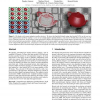Free Online Productivity Tools
i2Speak
i2Symbol
i2OCR
iTex2Img
iWeb2Print
iWeb2Shot
i2Type
iPdf2Split
iPdf2Merge
i2Bopomofo
i2Arabic
i2Style
i2Image
i2PDF
iLatex2Rtf
Sci2ools
TOG
2010
2010
Content-adaptive parallax barriers: optimizing dual-layer 3D displays using low-rank light field factorization
We optimize automultiscopic displays built by stacking a pair of modified LCD panels. To date, such dual-stacked LCDs have used heuristic parallax barriers for view-dependent imagery: the front LCD shows a fixed array of slits or pinholes, independent of the multi-view content. While prior works adapt the spacing between slits or pinholes, depending on viewer position, we show both layers can also be adapted to the multi-view content, increasing brightness and refresh rate. Unlike conventional barriers, both masks are allowed to exhibit non-binary opacities. It is shown that any 4D light field emitted by a dual-stacked LCD is the tensor product of two 2D masks. Thus, any pair of 1D masks only achieves a rank-1 approximation of a 2D light field. Temporal multiplexing of masks is shown to achieve higher-rank approximations. Non-negative matrix factorization (NMF) minimizes the weighted Euclidean distance between a target light field and that emitted by the display. Simulations and exper...
| Added | 22 May 2011 |
| Updated | 22 May 2011 |
| Type | Journal |
| Year | 2010 |
| Where | TOG |
| Authors | Douglas Lanman, Matthew Hirsch, Yunhee Kim, Ramesh Raskar |
Comments (0)

